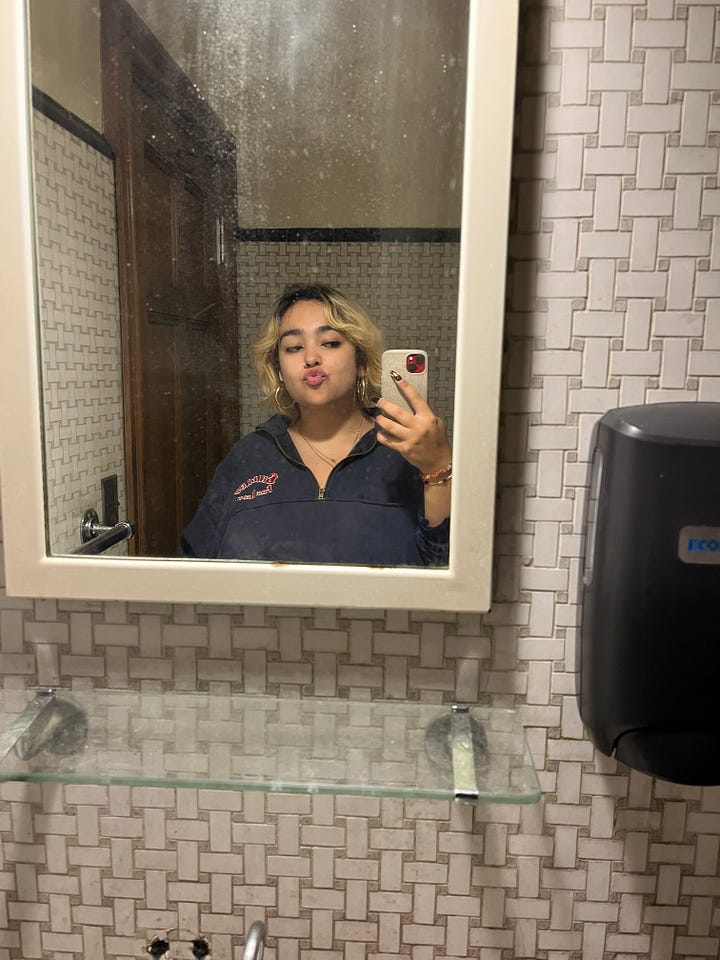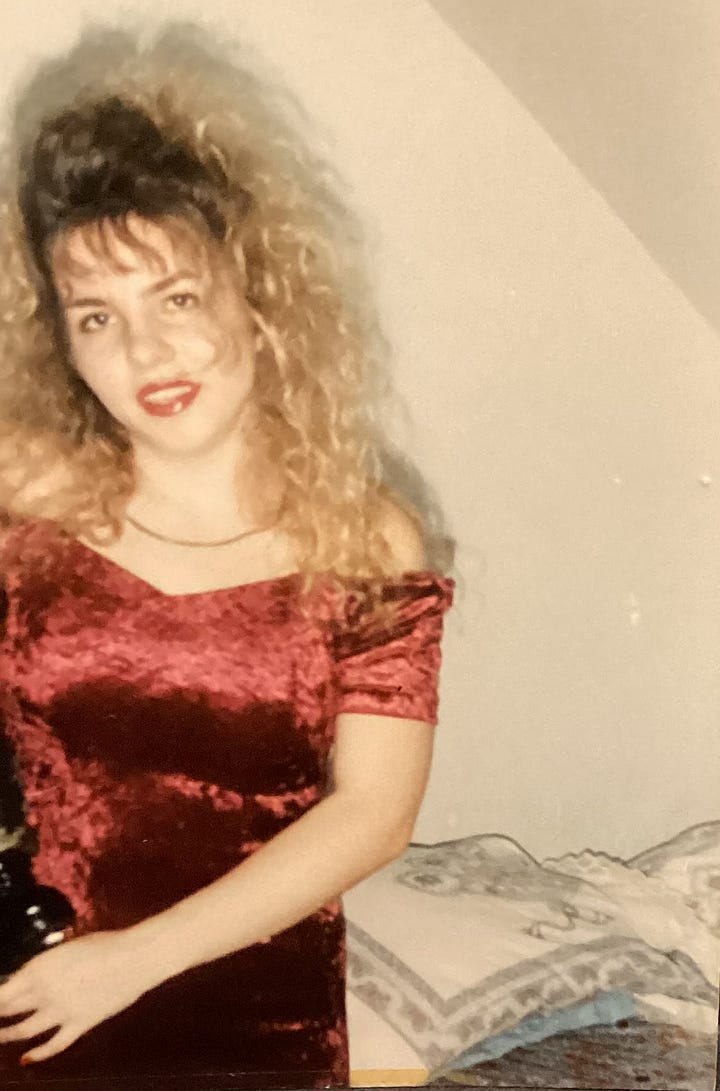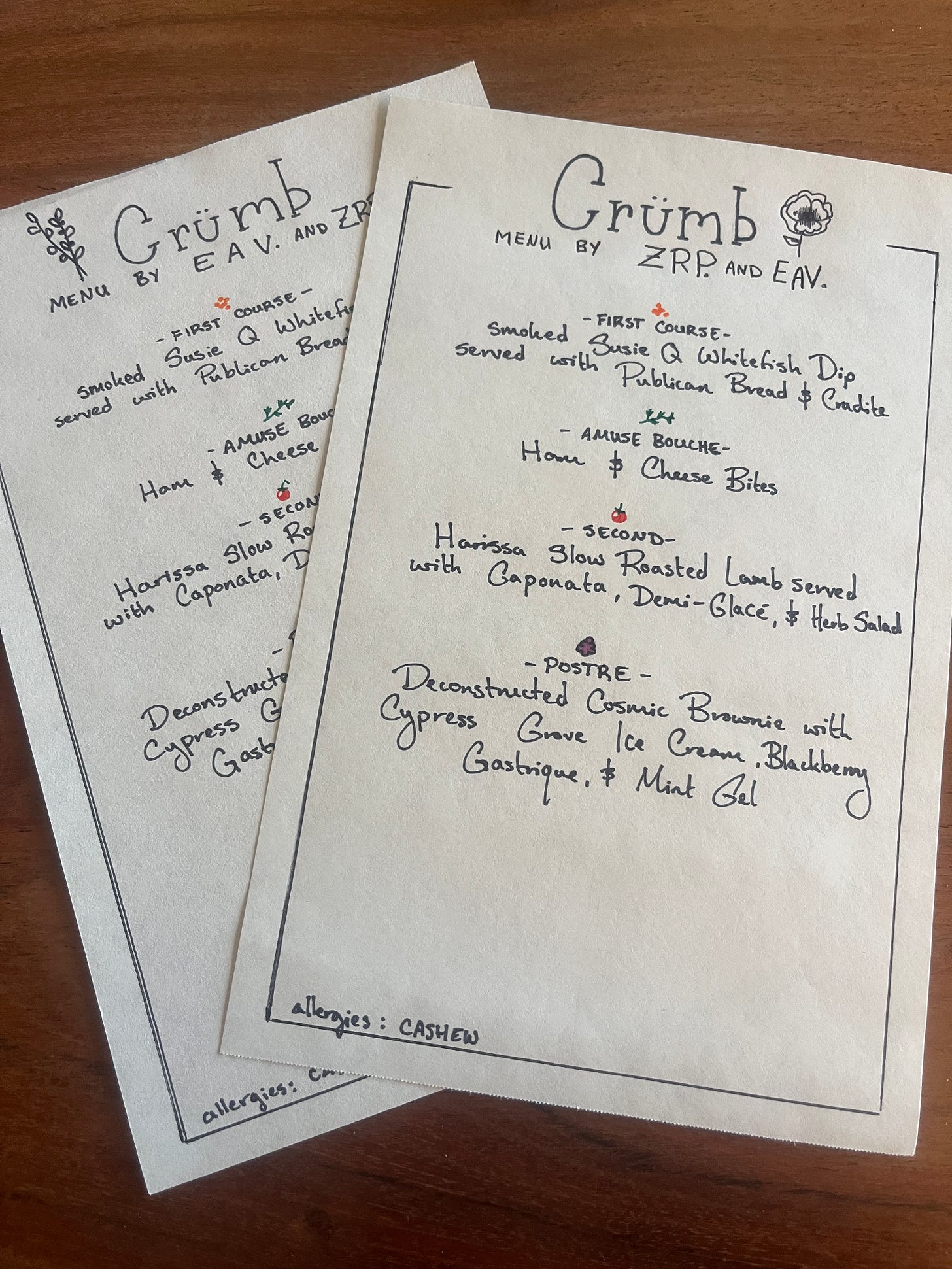The other day, my sister told me that I’m turning into our mother. She meant it in that persnickety way, aiming for that universal fear we all have of turning into our parents. Jesse had caught me fluffing my hair out in her mirror after our mom had teased it out with texture spray. “You’ve become a mini-Mom,” she said over my shoulder. For the first time in my life, I relished it like a compliment.
Our mother is renowned for being a diva. She gets what she wants. She wears all black with chunky gold jewelry and statement brown eyeshadow. I think I can count on my hand the days in the year where she doesn’t have a blowout. I don’t know what her real hair color is–she’s always been a warm, honeyed blonde to me. Her stories from youth are full of sleek Chicago drama, like drag races down Elston and nights clubbing with Scottie Pippen. In Bucktown, they used to call her Little Lady, or Roxanne. Rumor has it her tag still hangs somewhere on the 606. She’s bad.
I have never, in my life, felt cool enough to be my mother’s daughter. Although I have her ambition and determination, her pointed chin and the apples of her cheeks, I have always felt removed from her, looking at her from the outside of an invisible boundary. I have spent most of my life instead as my father’s child. I earned the moniker of “Frank Jr,” or “Little Frank” instead, mimicking the father-son sets in our family.
I thought this naming was just because we looked alike. I have my father’s complexion and his dark eyes, ringed with the same boyish lashes. I have his hands, with half moons edging the cuticles and rosy blush palms. Our real laughs come from the belly, all teeth and coughing smothered behind hands. I open my mouth, and his voice comes out, a melting pot of the Caribbean and old-school Chicago. His–our–‘th’ syllables are ‘d’s, just like the Saturday Night Live bit. His stories have become mine, illuminating the street corners of his childhood neighborhood that I inherited.
Maybe it was because we were inseparable since I was born. When my dad and I fight, my mom often consoles me with a reminder of my father’s attentiveness when I was born. The nurses made a very big deal about this while my mom recovered, telling her that our bond would be special, unique. I personally believe all parents should be equally present independent of gendered expectations. My dad can really get praise in the fact that he somehow still found time to bond with little me while working fulltime as a Chicago firefighter. Although he had more time while my mom worked a traditional nine-to-five, he was still exhausted when he wasn’t in the firehouse. Who wouldn’t be after hours of saving lives and inhaling soot?
When he fell asleep on the couch after shifts, I would wedge myself between him and the back of the overstuffed couch, at peace. Not once did he remove me or shout at me. He included me in almost everything. He encouraged me to play video games with him and my cousins on a laggy laptop. On the weekends, my dad used to take me on road trips to the suburbs to furnish his hobby aquariums and visit my uncles. I was a moon orbiting him, tied to him by a greater parental power.
This kept my mother at arm’s length. I couldn’t relate to her, especially as I grew more and more into a child uncomfortable with femininity. Any attempt to engage it felt physically wrong, inauthentic. There appeared to be no pathway from masquerading femininity, like playing in a mom’s makeup, to the realized product of being a girl.
So I ran from it, both literally and metaphorically. My mom used to chase me around the house in an attempt to make me wear studs to keep my ear piercings from closing. I hated to see her rounding the corner while getting ready for family parties, armed with her hot flat iron and her tweezers with her eyebrows arcing across her forehead.
I budded into the safety then of being a tomboy, cutting my hair close to my skull. I borrowed my dad’s clothes as I grew, burrowing into thermal t-shirts that left me perfectly formless. I remember distinctly being directed to the men’s room at concert venues, ushered off before I could correct anyone, and playing the male lead in the school musical (Tevye in Fiddler on the Roof, if you were curious).
I learned to live with people thinking I was a boy. It was easier, and it seemed inevitable. Masculinizing girls of color is an ingrained part of American culture. Add on being a fat girl, and you have the added pressure of making up for the socially constructed downside of your body. Your performance of femininity must be perfect to make up for your existence. A lax outfit of sweats and a messy bun on a thin woman is slovenly on a fat woman, unless she’s doing soft-glam and wearing a rhinestone sweatsuit.
If you reject being a woman period, or performing as a woman, you can slip away from this kind of pressure, and exist in a gender limbo. I accepted myself in this awkward state. But in my acceptance, I did not find satisfaction. Any chance I had to change this outward perception, to explore gender in a way that didn’t make me sick, seemed impossible. I dyed my hair pink in 7th grade, trying to inch towards appreciation for the color rather than repulsion. My peers were so confused at the prospect of me wearing pink that a boy started a rumor that my mother had been diagnosed with breast cancer. Another kid said Dunkin Donuts needed an advertisement. So much for experimenting.
Even with this pressure to either perform perfectly or not at all, I kept a small locked box internal. I coveted femininity, desperately. So I just kept edging closer where I could. I got really into earrings and dreamed of growing my hair long again (which I did, after about six years). At 14, I bought my first crop top, a soft floral halter top from Target in deep pinks and reds. I wore it around the house at first in the dead of winter just to get comfortable. She debuted that next summer, and stayed with me all of high school and college. The only reason I stopped wearing it at my grown age is because of a snag endured in the washer.
With the crop top, I tested the waters. But I needed a real good dip. My Sweet Sixteen came next. Honoring my multicultural upbringing, my mother decided that the party had the makings of a Quinceñera: gown, corset, petticoat, tiara, mani-pedi, and a pair of impossibly high heels for the opening ceremony. To say the least, I was terrified, haunted by past reactions to me performing femininity. I braced for the worst. This performance had the potential to ruin me.
These feelings swirled inside of me with the usual teenager cocktail of hormones, and I often lashed out. I think particularly of the long drive to the south side in search of a gown in dark October. My mom bubbled, excited as we drove down Archer Ave. I could not bring myself to match her energy. Instead, like any 15 year old, I checked out, stone faced. I smarted at every attempt she made to talk party planning. As girls and mothers do, we fought gloriously. It’s not that I didn’t want these things. Rather, I felt a fundamental disconnect between me and the vision my mother held for me, the one she wanted to give me so desperately. You always want better for your kids, and this is something she had dreamed of.
When we finally made it to the dress shop, after being denied dresses at other shops for my size, this shop gave my big ass options to try. The sweet girls who worked there buried me in shawls and swatches. Do you want sleeves or not? Do you want the skirt to be attached to the bodice or separate? Are we matching the shoes, the pillows for the ceremonies, the table cloths?
That night, I spun in a ball gown before my mom on a dais in the middle of the mirrored changing room. I learned how to move in a petticoat, how to climb and descend stairs gracefully. It came more naturally than I expected, proving helpful the night of when I heard “Suavemente” playing from the room over and I had to bolt. My makeup that night, in hindsight, looks a lot like how my mom wears hers now, the brown eyeshadow especially.
I had the real epiphany seven years later, while I visited home this past November. The same day Jesse sniped at me, I looked in the mirror while doing my makeup and did not recognize myself. Jesse was right. I had become my mother, drawn on beauty mark and all. I fully found secure femininity by emulating my mother.
If you ask my mom how old she is, she will always say 22. She says this so often that even my grandfather defaults to it. Growing up hearing this, the year came to carry a cosmic weight. What would my 22 hold? How could I live up to the stories she tells me? So I lived it, sometimes thinking of what she would have done in my shoes. Unintentionally, I found way more similarities than I expected. I entered this chapter with my hair blond with brown roots, just like her. As I prepare to close the year, I think I did the impossible: I lived up to her. For the first time, if I had met my mom at my age, I think we’d be friends.
Below is us at 22.


I asked my mom a few weeks ago how she felt when she found out she was having a daughter. She sighed into the phone, framed by a smile I could hear from the other side of the country. Of course she was excited. From the way she dressed me as a child, there’s no denying this as fact. Pink little sweat suits and chunky Barbie bicycle helmets. My first Halloween costume paid homage to the Princess and the Pauper. Braided pigtails held together by those hair ties with plastic beads on the ends.
Momentarily, I wondered if I’d disappointed her in this lifetime, deprived her of the experience of raising the kind of girl she wanted. Being the incredible mom she is, I know she’d disagree with me. Besides, no matter how complicated my relationship with my gender or my mother, we still had fun. She was the one who hairsprayed my mohawk into ridiculous peaks and took me with her to her bougie salons. She salvaged my graphic tees when the collars started to fray. Maybe I wasn’t the girl she expected, but I was still hers.
I don’t know exactly when we started to knit closer together. But I do know we have now to be those girls together. We have a rhythm now of shopping then lunch then a little treat when I’m home. I look at my mom now and see a smaller version on the inside, the girl who almost drowned in the Lane Tech pool and cut her wrist bringing home glass pop bottles. She’s in there somewhere, under Fenty highlighter and lots of hairspray. When we go to on adventures together, playing Madonna loud, I feel like I’m healing something. I think she is too.
Thank you always for stopping by,
EAV
RECIPE RECOMMENDATION CELEBRATION
I missed the holiday season by a mile. Now, it’s the new year. Every food content creator right now is crusading against the low-carbs and low-fat resolutions. Typically, a lot of content this time of year is about breaking through the carby haze of winter with a transition to salads of roast squash, homemade juice shots, and the beautiful citrus coming into season. For some reason this year, everyone has caught on that the new year isn’t a magic reset. Terrible things still happen, and sometimes we need to connect with our past through the security of food.
Personally, I’m with this new approach to January. It’s another way to stand against the heroine skinny that’s out of my 2025. January should not equate to restriction. Celebrate the new year all month long. Fuck it! Celebrate all year long! (DISCLAIMER: I do think you should eat some fruits and vegetables in the winter. Scurvy is real.)
Maybe it’s more accurate to say that I’m more for embracing a diverse kind of new year diet. For me, that has meant trying a lot of new restaurants, and learning new things in the kitchen. This is the time to scout for new and unusual comfort foods. Hopefully, they have fiber and some sort of leafy winter green. I think fondly of my roommate Frances’ Red Curry Lentils with Sweet Potato and Spinach, the recipe I love so much that I almost requested it for my birthday dinner. We cut the sweet potato with goat cheese crumbles and Frank’s Red Hot.
While I was home in Chi, I took advantage to explore things I am deprived of in the Hudson Valley. I won’t bore you with a ranked list of all the meals I had (unless you really want it…). However, I will flex the dinner party I hosted. Armed with an incredible budding chef as my partner in crime, the lovely Zane Perez, we worked for two days in advance to prepare our menu, pictured below.
When my guests arrived, I caught a twinge of panic. As Gill poured wine and Zane grilled sesame bread, my childhood friend Ellery made a joke about not seeing chicken tenders on the menu. Gill asked if anyone wanted to go get hot dogs and Italian beefs across the street afterwards. Uh-oh. Has our fearless dinner party leader Ina Garten ever been in this position? What would she do?
I started to sweat. Would they appreciate Zane and I’s hard work, or had we strayed into foofy territory? There is such a thing as too much, and being both foodie geeks, I feared we had found our limit. Truthfully, I knew from the jump some of my guests could be picky. A twisted part of me saw it as a welcome challenge. Zane and I are good cooks, but this would be a good test of just how good.
So I got up at 5:30 in the morning to roast the lamb. I went on a pilgrimage to specialty grocery stores across the northside with my dad as my sidekick, sampling smoked fish and scarfing down sub sandwiches (shout out Paulina Market). Zane and I tried to construct a flavor thread through the menu, almost like a narrative, to bring everything together. They better like that goddamn lamb, I thought, or so help me God. Worst comes to worst, I knew my dad would like the leftovers.
While the wine flowed, I looked around, nervous. My adventurous eaters were running late. I prayed for their speedy arrival to assure my picky eaters that I wasn’t trying to kill them. I decided then that we should begin with trout roe. Why? I don’t know why. Start with a bang.
The picky eaters panicked, balking at the little . Ellery’s lower lip curled back, like when Finn from Adventure Time gets spit on. “Eggs! Eggs! There are eggs in my mouth! Baby fish in my mouth and I don’t like it.”
That became the refrain for the night. Every time someone tried the roe, regardless if they enjoyed it or not, Ellery would repeat his observation. As much as I wanted to berate them to be serious, my friends still tried the roe off the back of their hands like champions. What were they going to think when I brought out my whitefish dip, let alone the goat cheese ice cream?
I had to trust myself, and the new amazing things I was learning in the kitchen. As much as this night could be about novelty for my dear friends, I also was trying new things too. Zane is a chef not only by passion but by literal trade. He can do things in the kitchen that I couldn’t do if you held me at gunpoint. For example, he makes an incredible mint gel. He cuts his chives rolled up in a damp cloth, just to keep them uniform. He carries a notebook with him wherever he goes, just like Sydney in the Bear, for ideas and inspiration. He’s everything I want to be.
As I cleared the table between courses, I noticed something. The plates were clean. The things that I feared would go untouched were decimated. It wasn’t just my garbage-disposal-type friends taking everyone’s scraps either. They came directly to the kitchen for their second helpings. Zane and I had won.
I tell you all of this to really push for experimentation in your new year. It doesn’t have to be as intense as fish eggs. How else are you going to give yourself the opportunity to be surprised?





So worth the read. Love the way you tell your story. I was intrigued the entire time, I really felt in your shoes ☹️👏🏼 btw momma and you are so flippin gorgeous!